Reborn in the Wirikuta Desert
I was invited by my host family to embark on a 9-day peyote pilgrimage through the desert.
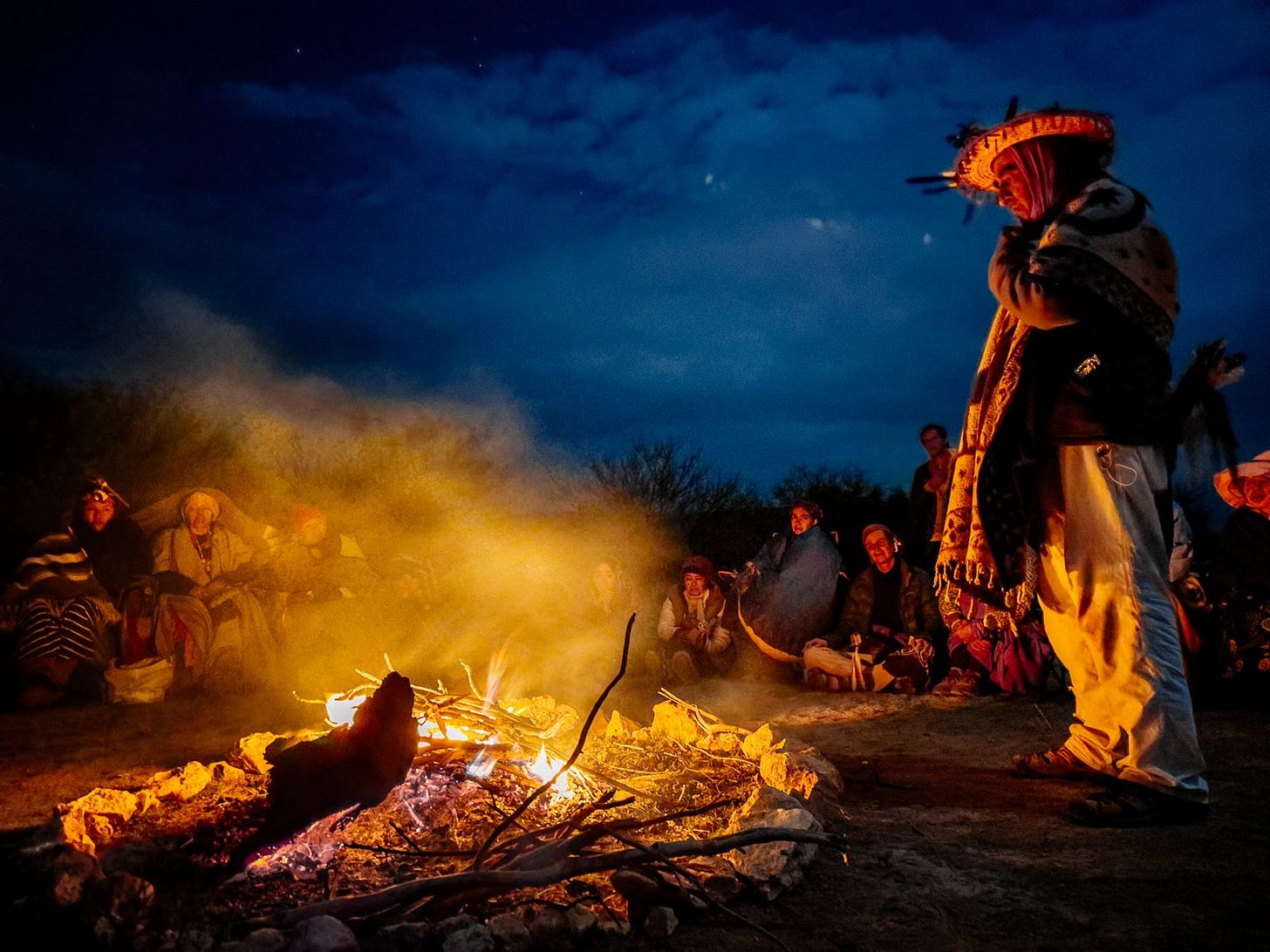
Before I begin, I want to start with a few notes:
With the rise of psychedelic tourism, there have unfortunately been negative impacts on the ecosystems from which the peyote plant is taken. Over the years, peyote poachers have been taking too much from the desert (to sell to tourists) and have not been harvesting the plant in the correct ways, so they are unable to grow back.
This plant is sacred to the indigenous people of this land, but is becoming more and more difficult for them to find due to extractive psychedelic tourism practices. So, if you do choose to seek out a peyote experience in Mexico, be sure to approach it mindfully by finding a guide that is in alignment with sustainable and ethical practices.If you come to the desert seeking a peyote experience be aware that you may be supporting harmful “companies” that take people into the desert without real consideration for their experience or the environment and sanctity of the plant and practices.
I’ve heard experiences from people that came to the desert in search of peyote. They found someone that sold it to them, took them into town to do some shopping while they were tripping, and then left them in the desert to find their way back. They said the whole vibe was shady, strange, and unsettling.
This plant is a heart opener, and if you are not properly cared for, it can do more harm than good, like any with psychedelic.
So, please just remember to always be mindful, be safe, and be respectful.
This summer, the 14-year-old daughter of my host, my hermanita (little sister), invited me to go on a 9-day peyote pilgrimage through the desert in Mexico.
She and her mother have been going since she was 6 years old, but her mother wasn’t able to go this year.
It’s important to understand that the peyote plant, also known as Hikuri, is not considered a drug. It is a sacred plant to the indigenous Wixárika people and part of their religious, spiritual, social, and communal practices. The experience is shared with the community across generations. Yes, children participate. It’s really an incredibly beautiful thing to witness family members across generations commune together in this way.
When I accepted her invitation, my hermanita’s face shone with excitement. She said, “it’s really, really magical and afterwards you feel like one big family. But that’s all I’m going to tell you because I want it to be a surprise.”
So, I squelched my curiosity and didn’t dig more into it. After all, I didn’t want to ruin her surprise.
I did, however, read about peyote poachers and the harm done to the plant and it’s ecosystem. I wanted to make sure I was entering into this experience in right relation, so a couple weeks before the walk I messaged our guide asking how long he’d been doing this and if the practices are safe for the ecosystem.
He replied, “I’ve been guiding people into the desert for 23 years and our harvesting practices are safe for the ecosystem. I will teach you how to harvest the plant so that it will grow back and we do not take any extra peyote out of the desert.”
I felt good about his answer and trusted the discretion of my host family, so I began packing for my journey.
Without planning it this way, this pilgrimage would occur just days after a solar eclipse in Libra and three days after my 35th birthday. It would culminate on our final night in the desert with a lunar eclipse in Aries and immediately afterwards, I would be moving my life to Oaxaca during Day of the Dead.
It all felt so big. I knew I was stepping into a huge death/rebirth portal in my life and I honestly couldn’t have orchestrated it better myself.
And so, the day after my 35th birthday I flew to Mexico with my life packed up into 4 suitcases and 2 days later I set off for the desert.
Upon our arrival at Pepe’s home (our guide), we were greeted with smiles and warm hugs from all the people there as if we were old family members that hadn’t seen each other in a while. It was an interesting thing to feel so fully embraced by complete strangers, but it all made sense by the end of the caminata. We were family, I just hadn’t known it yet.
After loading all of our food and gear, we piled into the bus, made stops throughout the night to pick people up, and arrived at our starting point just before sunrise.
Bleary-eyed and with only a couple hours of broken sleep, we donned our faldas (skirts) and walked up a small hill overlooking a huge expanse of desert. The land was dotted with shrubs, cacti, and Joshua trees and I stood there, fingers and nose numb from the cold, watching as bright orange clouds blazed like fire over the horizon.
Staring across that great, flat expanse I thought,
“We’re gonna walk through that… holy shit.”
On the hill we built an altar and gave our offerings of a candle, a small mirror, a peso, and a piece of cacao. The altar was decorated with various items from pictures of Jesus, Mary, and Buddha, to crystals, bones, feathers, and children’s toys. Whatever held significance for you could be placed on the altar.
Conches blared loudly into the quiet morning and Pepe offered prayers to the elements, indigenous deities, catholic saints, and the four directions (this blend of old and new, prehispanic and colonialist religions is something we’d see throughout the caminata).
While two men of the group began building the sacred fire, Pepe shouted, “faldas!” The experienced women snapped to attention, gathered around the fire and fanned their skirts wide to block the wind. We all sang songs together until the sacred fire came to life and we could feel the warmth of it on our cold cheeks.
To be honest, I had no idea what was happening or what to do. I felt like a fish out of water, standing around like an idiot. My Spanish was a little rusty after 2 months back in the states and they just dove right in. No orientation, no instruction. So, I simply followed along. Witnessing. Observing.
This caminata wasn’t an exposition. Newcomers weren’t really formally told and taught what to do. It wasn’t workshopped. We were completely immersed in the traditions and ceremonies—oftentimes with no explanation—and had to follow the lead of our guide and receive extra guidance from elders and community members.
This wasn’t about “demonstration” or tourism. We were simply being allowed into this world, to witness, experience, and be a part of it.
We took turns introducing ourselves to the sacred fire, Abuelito Fuego (Grandfather Fire), and stated our intentions for the caminata. It was one of several conversations to come with Abuelito Fuego.
After the opening fire ceremony, each person was assigned their position in line that would be their position for the entire caminata—alternating men and women, experienced walkers interspersed with newbies.
We assembled ourselves in single file and walked in silence as a collective. A long serpent almost 40 people long traversing the desert as one.
We walked through the desert for 8 days.
Some days were short, but most were long. On our longest days we walked over 30km beginning at sunrise until well after sunset.
Day after day we walked with swollen hands and feet, blisters, sore muscles and aching joints. We walked through the heat of the sun, the cool rain, and felt immense gratitude for clouds when they graced us with their presence.
When we arrived at camp after a long day of walking we were greeted by those that couldn’t walk with applause, cheers, whistles, high fives and, “bienvenidos, guerreros!” (“welcome, warriors!”). We endured physical, mental, emotional, and spiritual challenges, but we endured them all together.
The energetic support of the serpent is felt. The invisible cord of those pulling you from ahead and those pushing you from behind.
Throughout the caminata we shared snacks, tended to each other’s blisters, and massaged each others tired backs. We laughed as we pulled cactus spines from each others butts and we shared our stories and our dreams. We held each other through tears and reminded one another of our strength when things got tough. The unconditional support of the community is a big part of the medicine you receive on this journey. It strengthens you in ways that only community can.
On day 2, rolling thunder and a cool breeze followed us as we arrived at camp after a long, arduous day of walking. In just a few moments it began to pour and we all scrambled to set up our tents and get our things out of the rain. After setting up my tent, rainwater dripping into my eyes and soaking through every layer of clothing, I rushed to help my neighbor whose tent pole had snapped. I offered her my tent pole splint, got her tent set up, and crawled into mine to change out of my soaking wet clothes.
After a few minutes of taking shelter, I heard people howling, hooting, and hollering. I unzipped my tent to peer outside and saw people gathered together howling excitedly at the sunset. I turned to the east and saw a huge rainbow painting the golden sky. I’d never seen a rainbow so big and so complete! I jumped out of my tent to snap a photo and saw my hermanita walking slowly toward me. I urged her over to take a picture with me only to notice that she had been crying.
I held her as she cried into my shoulder, “all my things are wet, I don’t know what I’m going to do or where I’m going to sleep. This is hard. I miss my mommy.”
That night, she, my friend, and I squeezed into my tiny 2-person backpacking tent. We ate our dinner huddled in that small space and sipped on hot cocoa together. We slept like sardines, but we were dry, warm, and after it all, we were content.
There is deep psychological work that is done in the physical aspect of the walk.
Para fortalecernos—to strengthen us. To show us how we can show up amidst and through struggling. That we can. And that it can be joyful as much as it is challenging.
Witnessing my hermanita as she moved through her emotions reminded me of my toughest days in the Patagonian wilderness. Body aching, hips bruised, lips dry and cracked, freezing temperatures, 40mph winds, and trudging through rain and snow. That wilderness had pushed me further physically than I had ever gone. It pushed me to my edge. But through that experience I got to discover previously unmet parts of myself. It stretched me. I got to see what I was made of. What I was really capable of. And I hope that’s what the desert storm had done for my young hermanita. I hope it revealed to her more of her own strength, grit, and capacity for enduring the challenges that life brings.
I believe in the power of struggle to transform us. Once you are pushing your physical limits, you will inevitably meet your mental ones. The creeping, lurking, limiting beliefs (“I can’t”, “I’ll fail”, “I want to quit” etc.), but the thing is, when you’re far out there in nature, you have almost no choice but to not succumb to them. That’s where the magic happens. Beauty in the breakdown.
It’s powerful alchemy.
Turning struggle into strength.
And you take that strength with you throughout your life.
Before ever even tasting the medicine, so much work had already been done.
While walking you are meant to contemplate your intentions, why you’re here, what questions you have, what clarity you are seeking, and what you’re working on. You ask questions and step by step—paso a paso—the desert slowly reveals insights, revelations, and wisdom. Like polishing a dirty mirror, stroke by stroke, clarity comes. It is a contemplative practice. A walking meditation.
Walking in silence every day. Hour by hour. We chewed slowly on our intentions and contemplations the way we chew slowly on the medicine. Bit by bit. Poco a poco.
We passed through tiny desert pueblitos with only a handful of homes for miles around where dogs, horses, and cows seemingly outnumbered people.
We took breaks in the forgiving shade of shrubs and Joshua trees, napping, resting our feet, and breaking the silence to get to know one another.
On day 4, we slept in a small church in a little desert town. While most turned in early, some of us stayed up a little later and shared some mezcal and conversation. One man who had been walking for 3 years advised me:
“During the medicine ceremony, don’t look around at other people. Don’t worry about what other people are doing. Just look into the fire. Contemplate your intention and stare into it. Leave what you need to leave in the fire and let it all burn it away. Abuelito Fuego will bring clarity and reveal to you your path. I know your friend invited you here, but it wasn’t them that invited you. The desert called you through them. Know that. You are here for a reason. It’s not a coincidence. And remember this:
Fuego is ‘fue-ego’. The ego was (or went).
Desierto is ‘de-ser-cierto’. To be certain, true. To be clear.
This is the medicine of the desert.”
His words will stick with me forever.
The next day, we entered the Wirikuta Desert, the desert lands sacred to the Wixárika people.
After passing through the gateway to the Wirikuta, the flat, dry desert landscape came to life with greenery and mountains. As we approached the next sacred site, the newcomers were blindfolded and paired with an experienced walker that would guide us as we walked to the next ceremony site. I won’t go into too much detail here, but it was a beautiful experience in trust, walking in darkness, burning away that which you want to leave behind, and being reborn and welcomed into the sacred lands of the Wirikuta Desert.
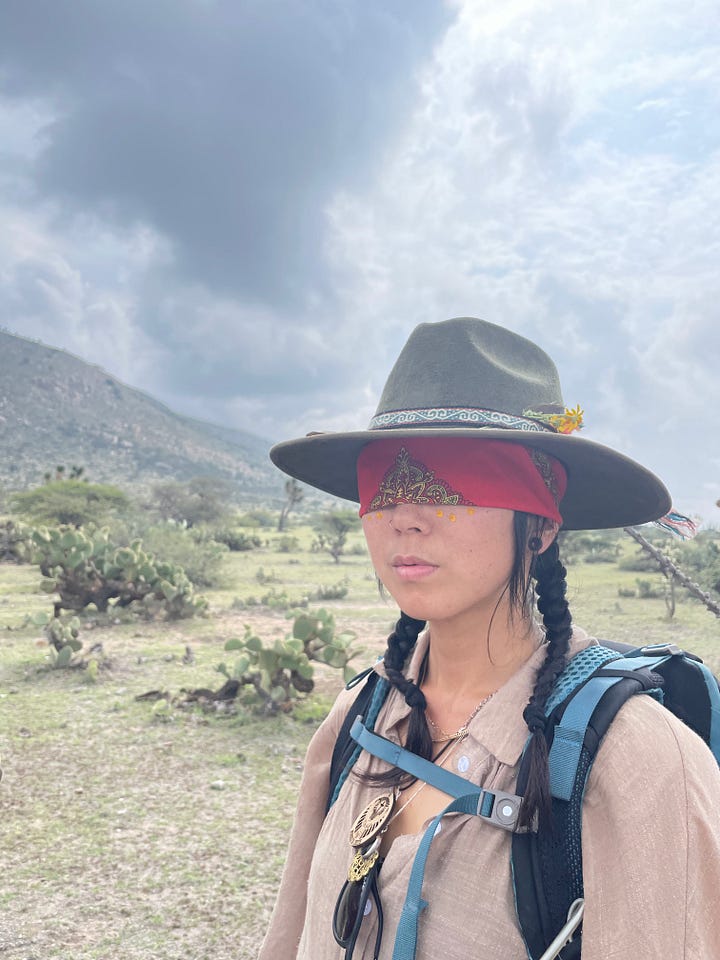
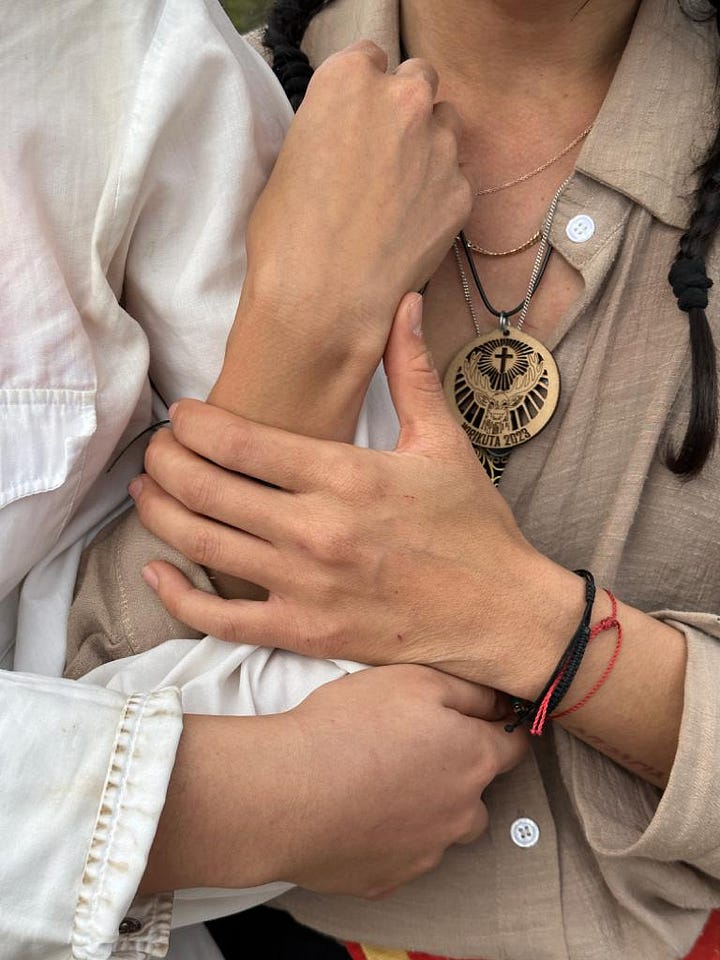
The next morning, we were instructed not to eat (other than an apple or two) or drink any water all day. After a relatively short walk and setting up camp, we sat together under the shade of a tree and Pepe taught us about the sacred Hikuri plant.
We learned how to harvest the Hikuri correctly and with respect. He taught us where to look and how to clean and prepare the plant for consumption. And he taught us how to identify their maturity, to leave the young plants to grow and the old plants to be.
We were instructed to walk like desert animals. To feel the breeze. To commune with the desert as we walked, allowing its intelligence to move through and around us.
After our lesson, we cleared our energy with the branches of a guardian plant and set out into the desert to begin our cosecha (harvest).

Within a few minutes, I found my first Hikuri plant.
I greeted it and talked to it, giving it my respect and gratitude and, after harvesting, I left an offering, covered it with dirt and resumed my cosecha.
I was advised to consume a piece of my first harvest to connect more deeply with the desert and spirit of the plant while I searched, and so I did. I gently cleaned the soft, squishy plant, pulled apart a petal like you would a piece of mandarin, and put it in my mouth. It was succulent, bitter, and a little acidic. It wasn’t delicious, but it also wasn’t terribly unpleasant.
I continued to walk chewing on the medicine, feeling the gentle breeze as it blew across the desert and sang melodies that rose from my heart. The harvest continued until someone found the sacred “Hikuri family”. The conch sounded and thus the cosecha ended.
We regrouped with our harvests and Pepe created an altar next to the Hikuri family. There we held ceremony to thank and honor the spirit of the plant, the elements, deities, ancestors, and nature. We each received blessings and Hikuri from Pepe and began to consume, bit by bit, the sacred medicine.
We sang, we prayed, and we took turns blessing one another and sharing medicine. The energy was jovial, celebratory, and we all laughed and hugged deeply as the medicine began its heart-opening work.

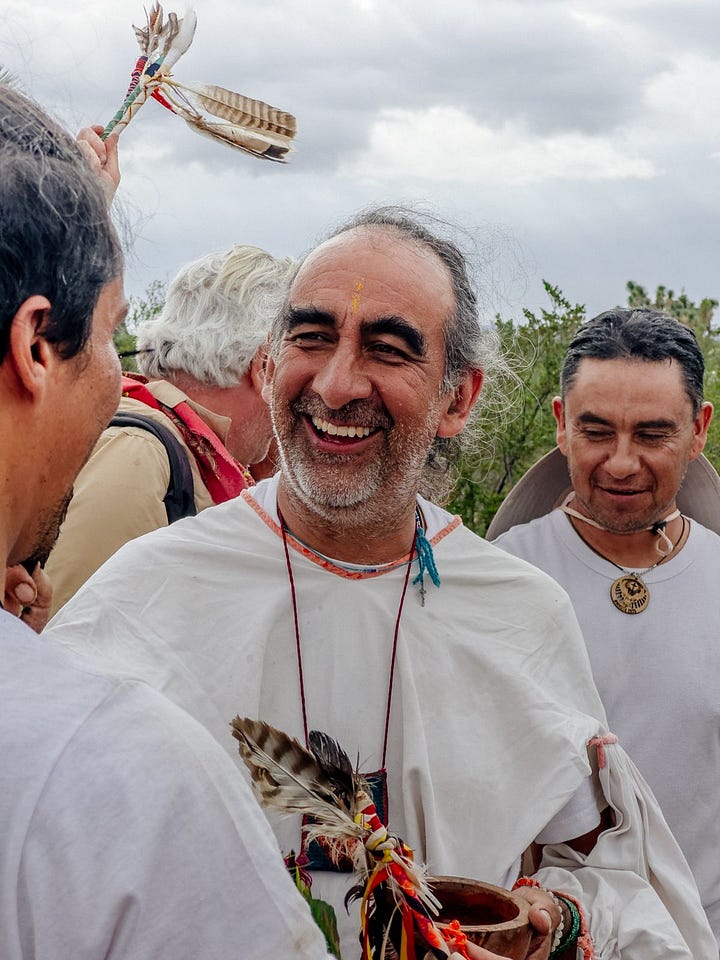
After the cosecha, we returned to camp to rest before our medicine ceremony. The ceremony would start at 10:00pm and go until sunrise. We would not eat or sleep and we would continue our walk the next morning. Some of us napped, some of us didn’t, but all of us enjoyed the afternoon and evening of resting our tired bodies.
The experienced walkers joked, “si tienes hambre, Hikuri. Si tienes sed, Hikuri. Si tienes sueño, Hikuri.” (“If you feel hungry, Hikuri. If you feel thirsty, Hikuri. If you feel sleepy, Hikuri.”) And though it was a joke, it was legitimate advice for getting through the all-nighter.
After consuming a few pieces of Hikuri over the course of a couple hours, colors were brighter, hugs felt deeper, and laughter was abundant. And though not much changed visually, when I closed my eyes, I could see faint geometric patterns flickering behind my eyelids. The prominent pattern I saw was the “Ojo de Dios” (“God’s eye”). I understood then where the inspiration for these pieces of yarn art that I’ve seen all over Mexico and South America comes from.
After a while of laying down in my tent watching the colorful show behind my eyelids, the Ojo de Dios patterns flickered and morphed into the face of a young indigenous girl, then an old indigenous woman, and then back to a young girl.
She stared at me expectantly, as if waiting for me to do something. I felt that they were guarding something. That I was meant to humble myself and ask permission to be there. And so I did and the visions faded and I rested.
After lazing around the campground and sharing conversations and laughter, at 10:00pm, the fire-tenders created a sacred fire and we gathered around it to begin our ceremony.

The circle was divided into two halves, masculine and feminine, in order to mitigate for any exchange of sexual energies throughout the medicine experience. This was an important aspect emphasized by Pepe and the elders in order to maintain mutual respect and healthy boundaries while peoples’ hearts open with the medicine.
Throughout the night around the sacred fire we continued to consume the Hikuri. If we were thirsty, Hikuri. If we were hungry, Hikuri. If we were tired, Hikuri. And hour by hour the medicine slowly did its work.
The medicine was gentle in the way it cracked your heart open.
Little by little.
Bit by bit.
But once you reached the point of opening, there was no going back.
You had no choice but to surrender to the tidal wave of catharsis as it broke your heart completely open.
Each person took a turn to speak to the fire. To share their intentions, their wishes, their pain, their joy. To share their good news or their suffering. To ask for strength, discernment, hope, integrity.
Each person left what they needed to leave behind with Abuelito Fuego and was cleansed and blessed by the community as they walked around the fire and reintegrated back into the circle.
Hugs. Tears. Laughter. Sorrow. Song. Silence. It was all present.
We gave it all to the fire to transmute and we held one another in a collective energetic cocoon of love and safety throughout.
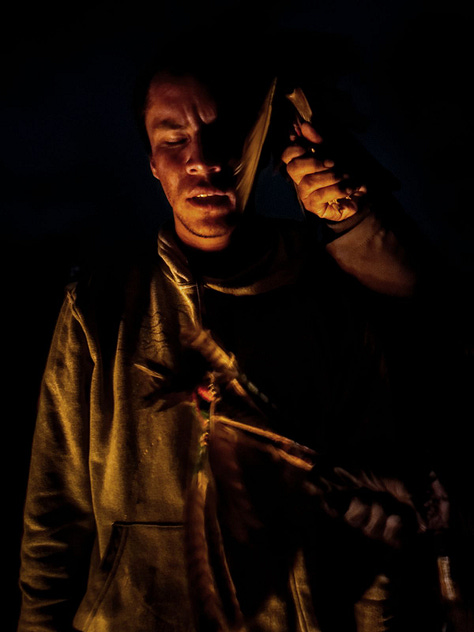


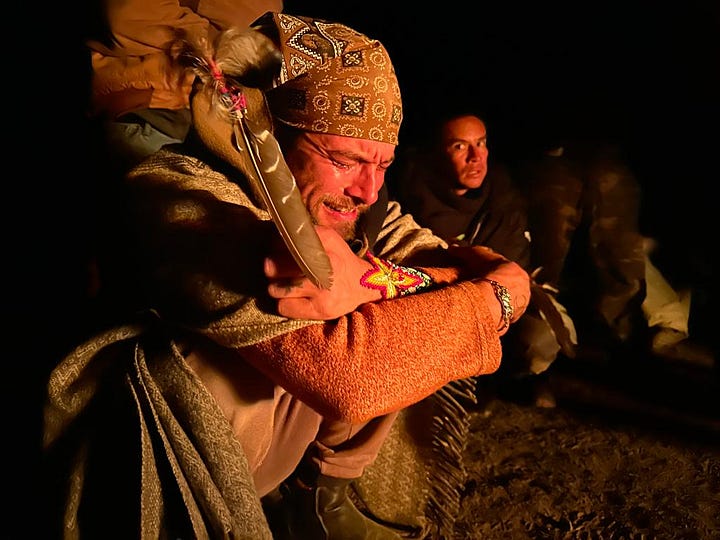
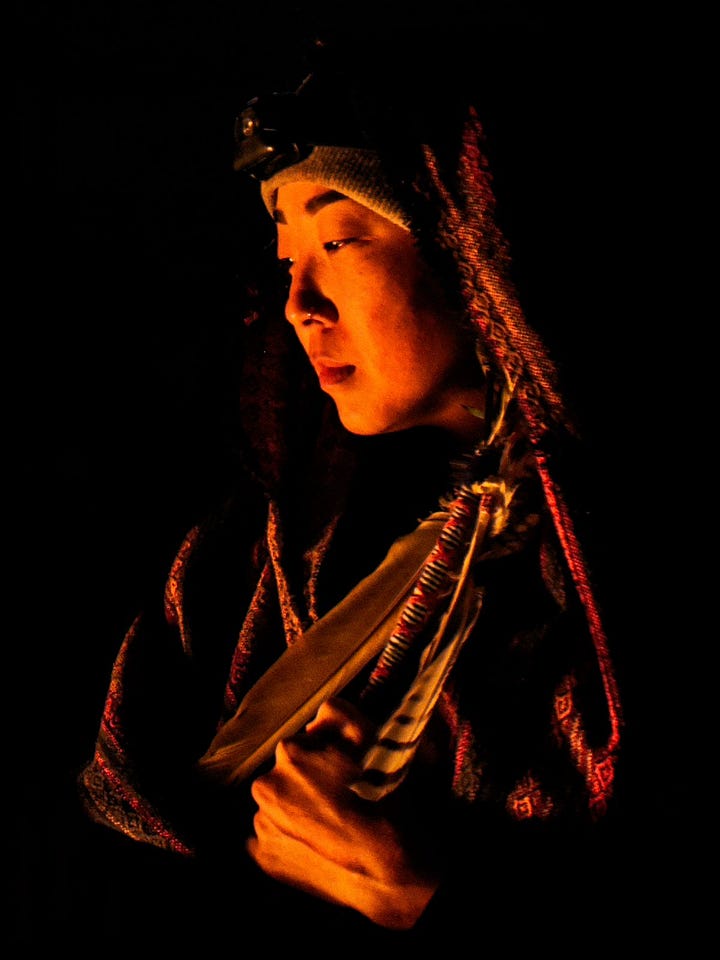
It wasn’t until daylight already broke that I spoke to Abuelito Fuego.
I contemplated for days, hour upon hour, step by step during the caminata what I would share with Abuelito Fuego. I had rehearsed it over and over in my mind, but feeling shy to speak Spanish, I held off.
As I witnessed each person bare their soul in front of the fire, my heart cracked open. Slowly, with every story, every word, every tear, every hug. At one point, I began to cry as a tidal wave of emotion flooded my being. My heart broke open the way a dam would and I couldn’t stop the tears.
One of the women turned to me as tears streamed down my face and whispered, “it’s time for you to speak to Abuelito Fuego, my dear. It’s time. Go.”
And so I did.
I knelt down on my knees and greeted Abuelito Fuego. Though I had contemplated for days my own path, my move to Mexico, my work, my purpose, my life, all I wanted in that moment sitting in front of the fire was to ask for support for those I love most in life. The people in my life that were suffering most. That was the most important thing to me and in that moment I understood what my friend meant when he said, "fuego = fue-ego.”
After sharing, I walked around the Sacred Fire and received blessings from the members of the community. As I returned to my place around the fire I found myself sobbing in the arms of the woman that encouraged me to speak to Abuelito Fuego.
While crying on her shoulder, I felt more people envelop me in their arms. They whispered words of encouragement, strength, hope, and love as they held me.
In the safety of that collective embrace all of the protective armor around my heart crumbled and I let myself fully surrender to the catharsis of that beautiful, sacred, healing moment.
This pilgrimage wasn’t really about tripping on peyote.
It wasn’t about having a blast-off, transcendental experience. It wasn’t about seeing god or becoming godlike.
It was really about community. Being human. Healing together. And connecting with the earth, one another, your heart, and your path in this life.
This experience taught me that peyote is a medicine meant to create safe, nonjudgmental spaces within communities. To open our hearts so we can grow together and learn from one another.
It is here to support us in supporting one another, in hearing one another’s stories. Our joys and celebrations, our darkest shame and pain.
And, the thing is…
To be witnessed and seen in all of that,
to give it all to the fire, alchemize it in the flames, and come out cleansed and reborn,
and most importantly, to be celebrated by your community in that process no matter how ugly or messy,
that was where the real medicine was.
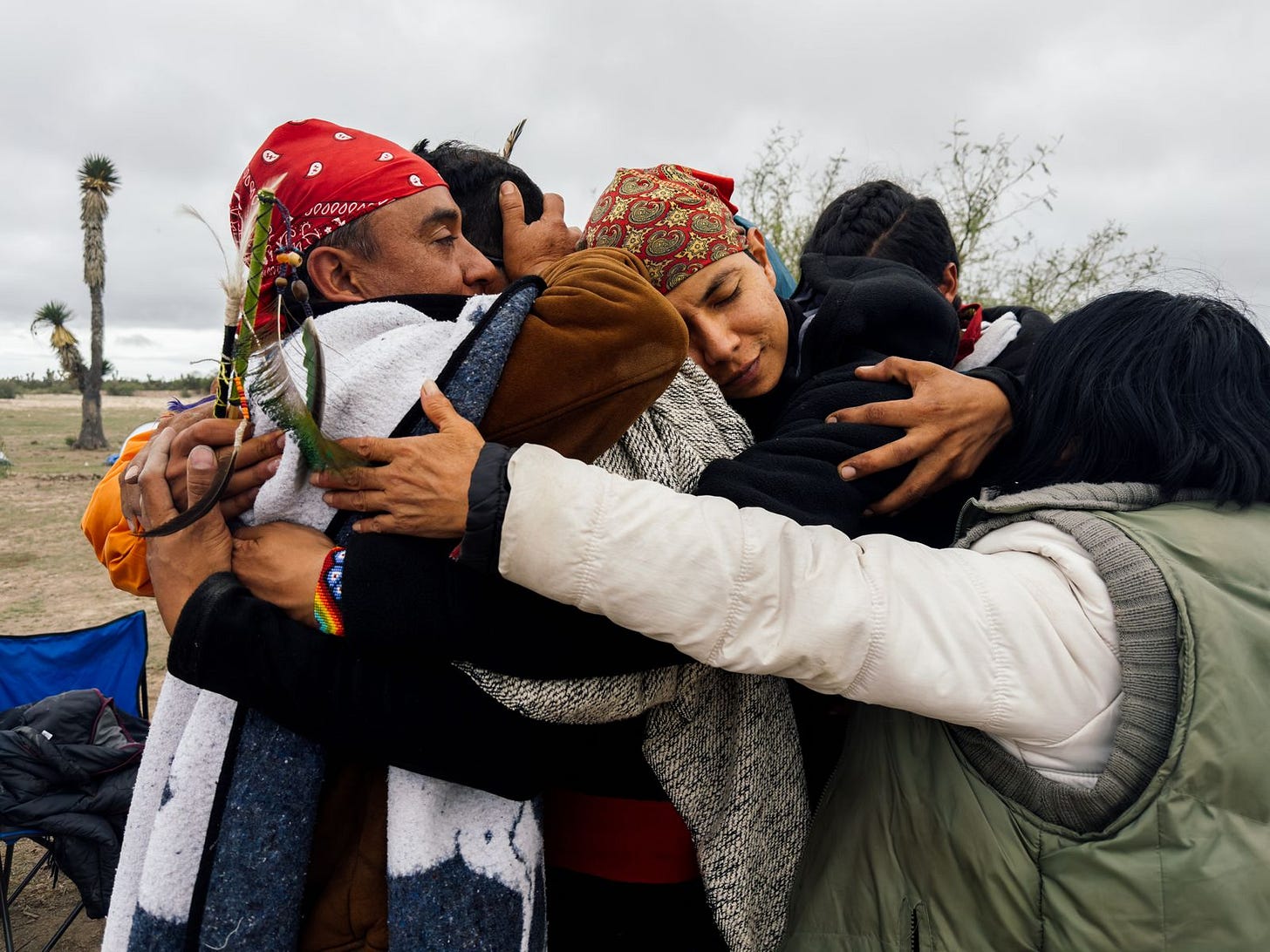
The real medicine was in showing up and being seen and held by your community. Being vulnerable and opening your heart. Integrating your shadows while being supported and witnessed in your process.
It was so deeply human. And it was so beautiful.
I thought about how healing these experiences could be for every community, every family to participate in. I thought about how different my relationship with my mom would be if we walked together. How much more connected to my ancestors I would feel if this was a part of my life since childhood.
I thought about how much more supported our young people would feel with this type of multi-generational guidance and a connected, nonjudgemental community. And I thought about how different the world would be if more practices like these survived colonization in our modern culture.
Practices that teach us that we don’t ever, ever have to walk alone.
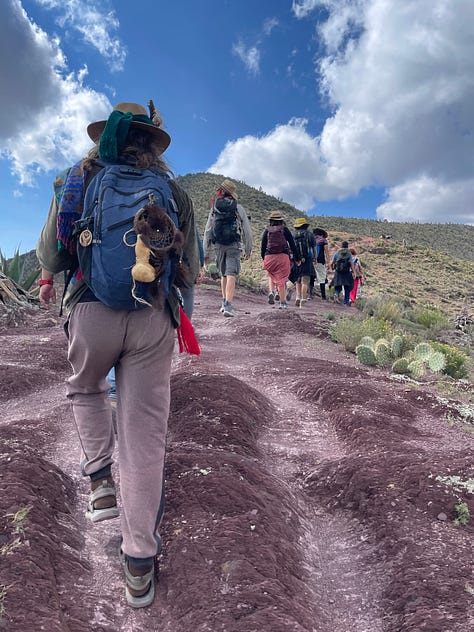
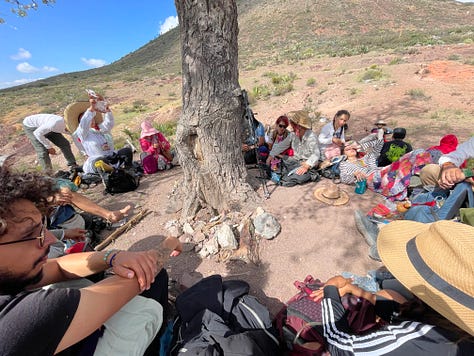
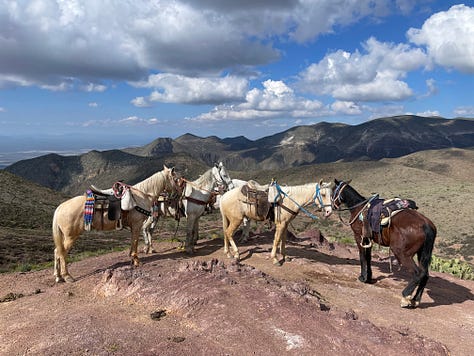
After sunrise, we completed our ceremony, packed up camp, and continued our journey with little food and zero sleep.
We consumed more of the Hikuri to get us through the day. It energized. It quieted hunger, thirst, and pain. It awakened the spirit and attuned us more closely with the desert. And we walked.
On our last day we hiked up the sacred mountain of the Wixárika people, Cerro del Quemado. Up on the mountain we had our closing ceremony. We shared our hearts, sang songs, remembered loved ones that could not be there, and held one another as we watched the sun set beyond the horizon. We shared medicine, music, and mezcal. It was a ceremony and a celebration.
I cried at the bittersweetness of coming to the end of our journey together. Reflecting on the challenges and joys and everything in between. I looked around at all my fellow warriors young and old and thought, “how beautiful it is simply to be human, together.”


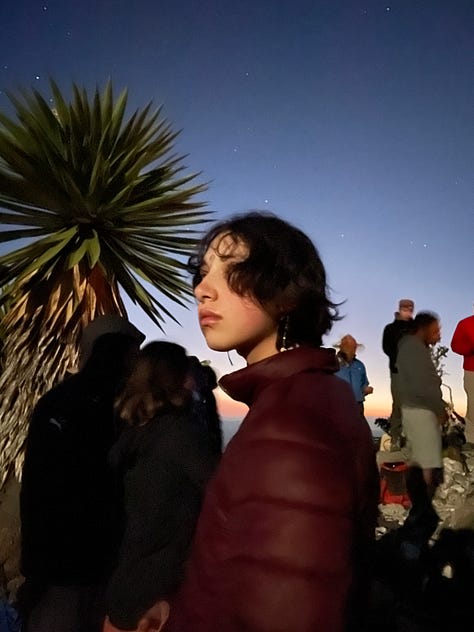


We sat atop the sacred mountain and watched the full moon rise from behind the horizon in the distance. When the ceremony ended, we each took our places in the serpent and walked back down the mountain in single file, without our lamps, to the light of the full moon.
Beautiful photos by: Charles-Henry Bédué






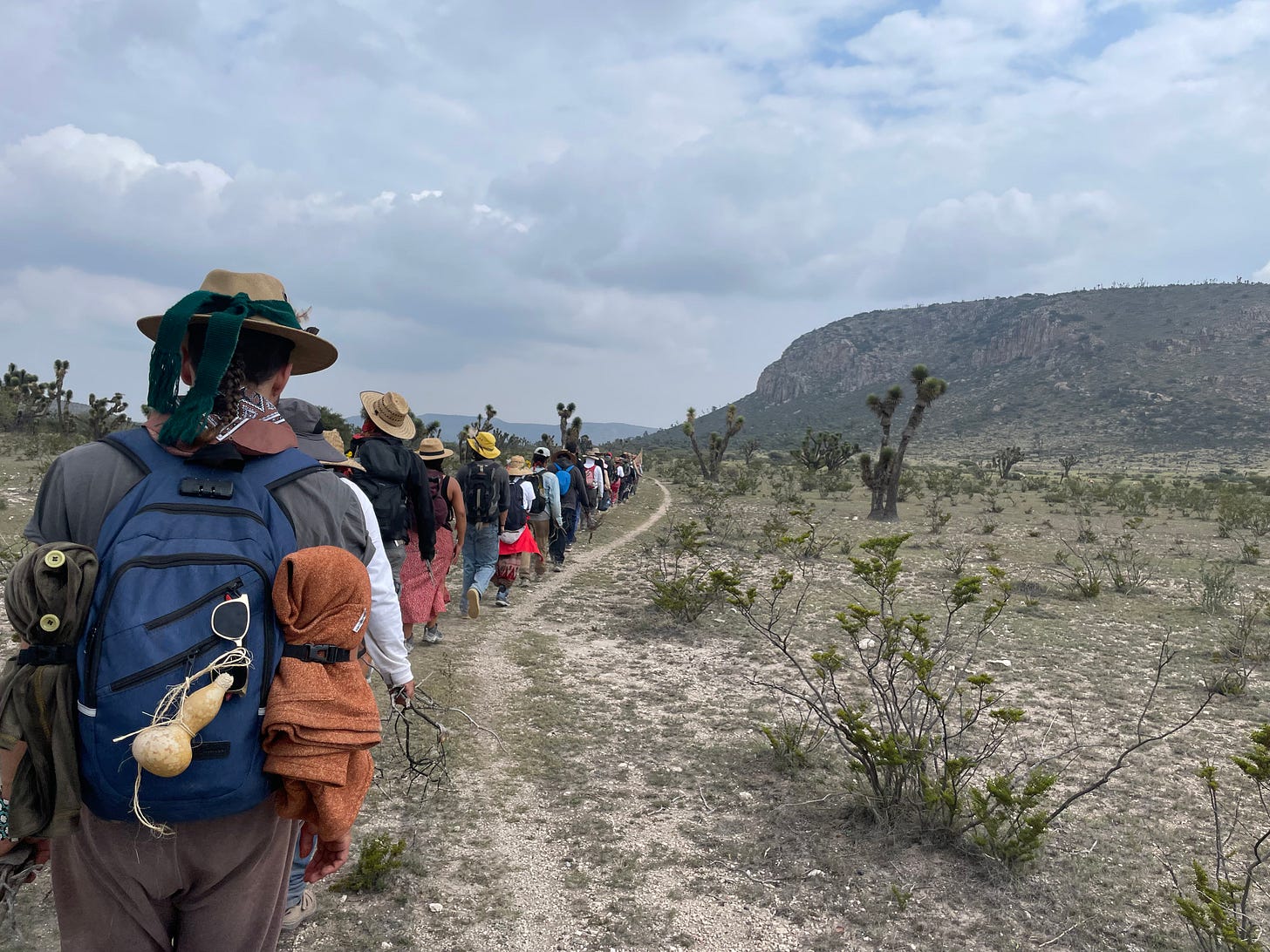

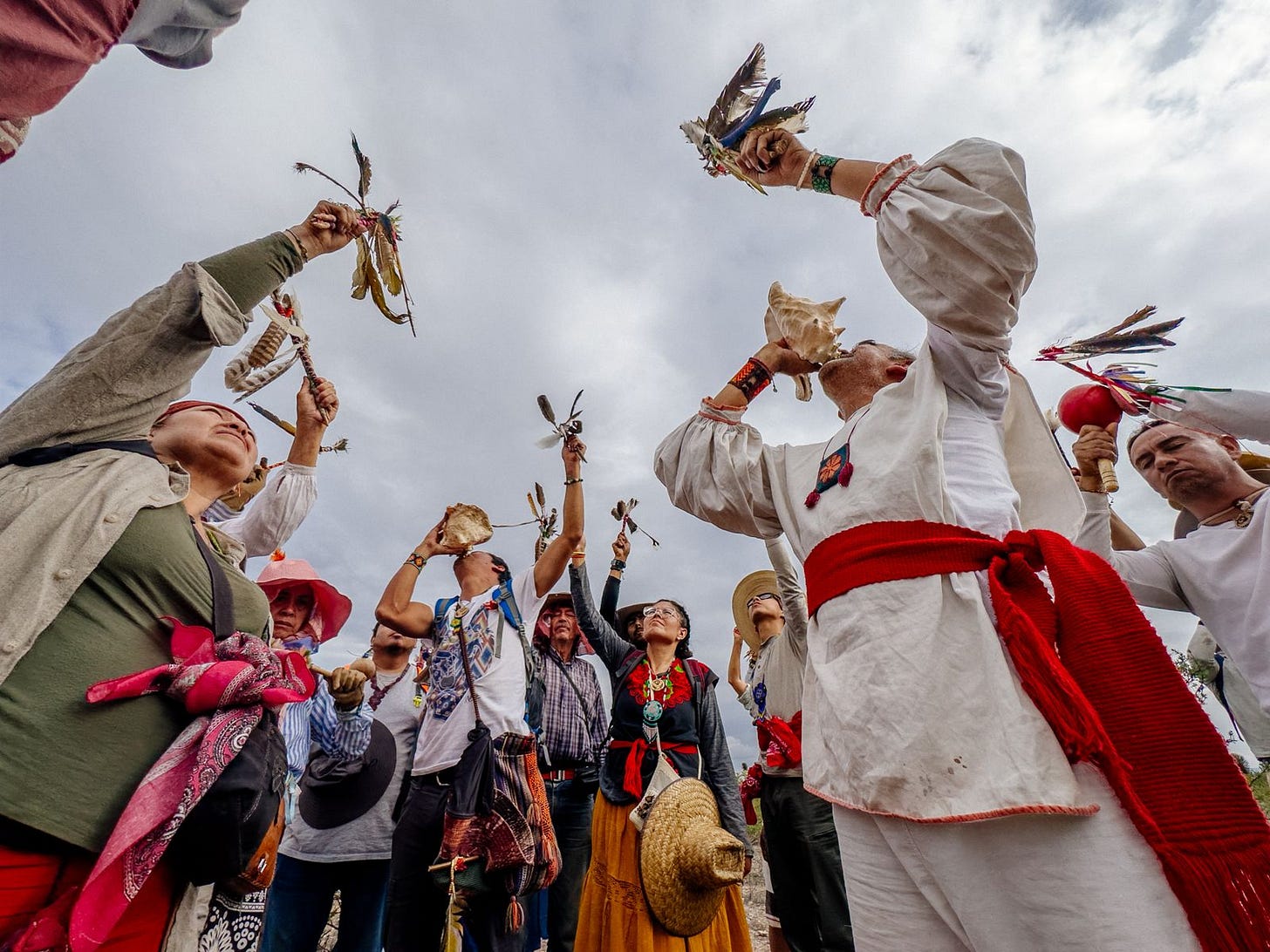
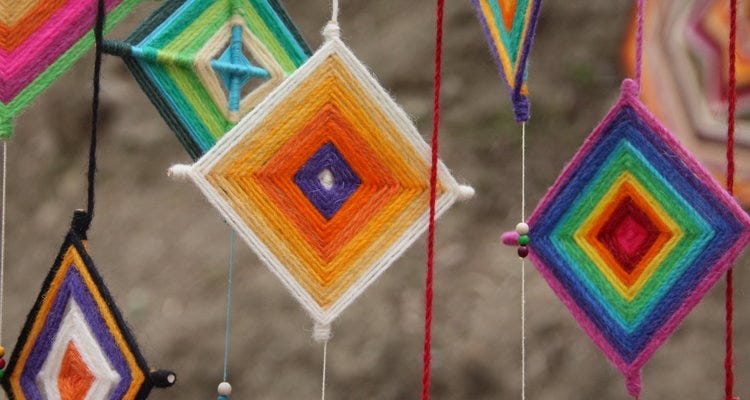

Thanks for sharing. It was well-written.
Also, photos were dope and I was impressed by your skills. And then you PCed someone else lol.
That was an amazing read ♥️